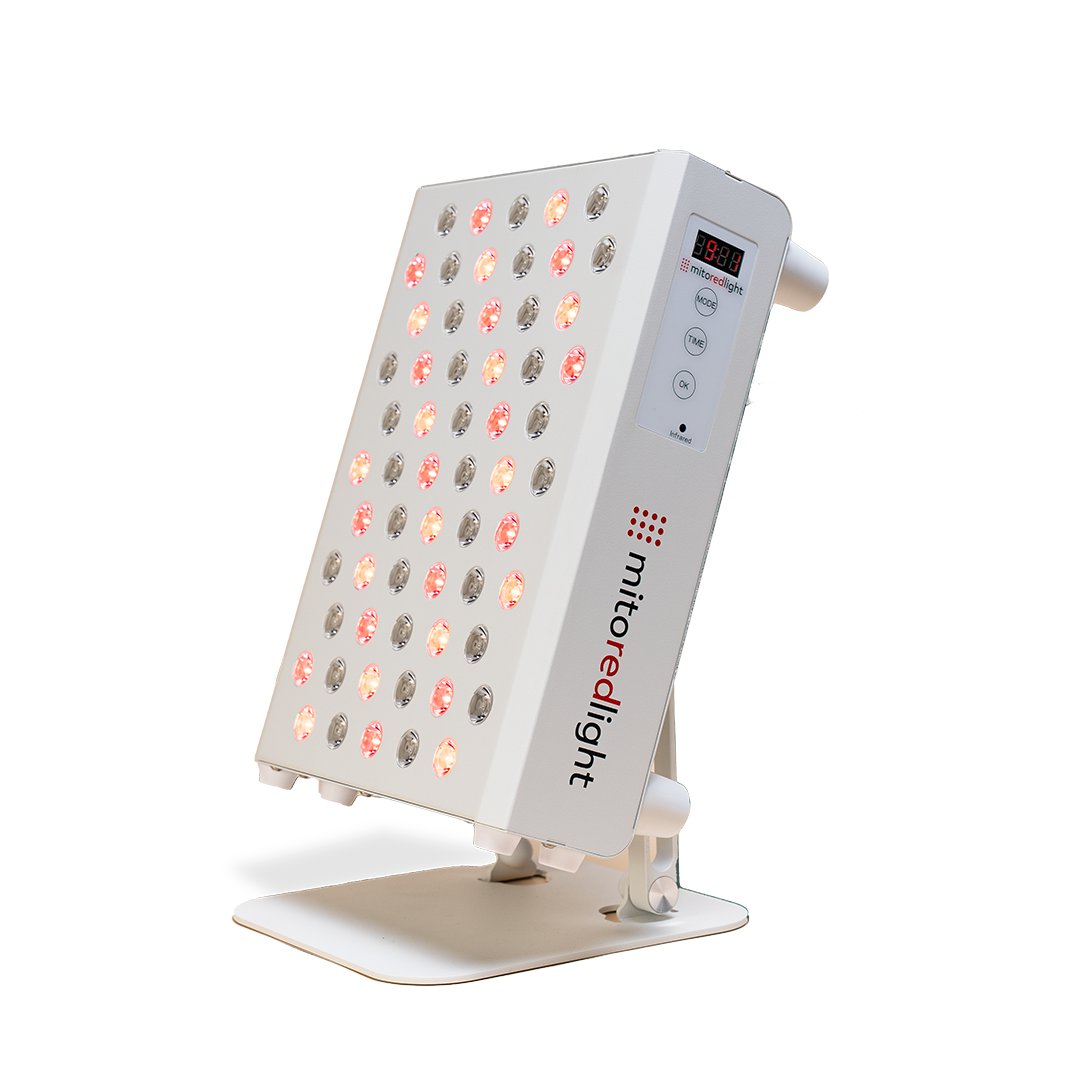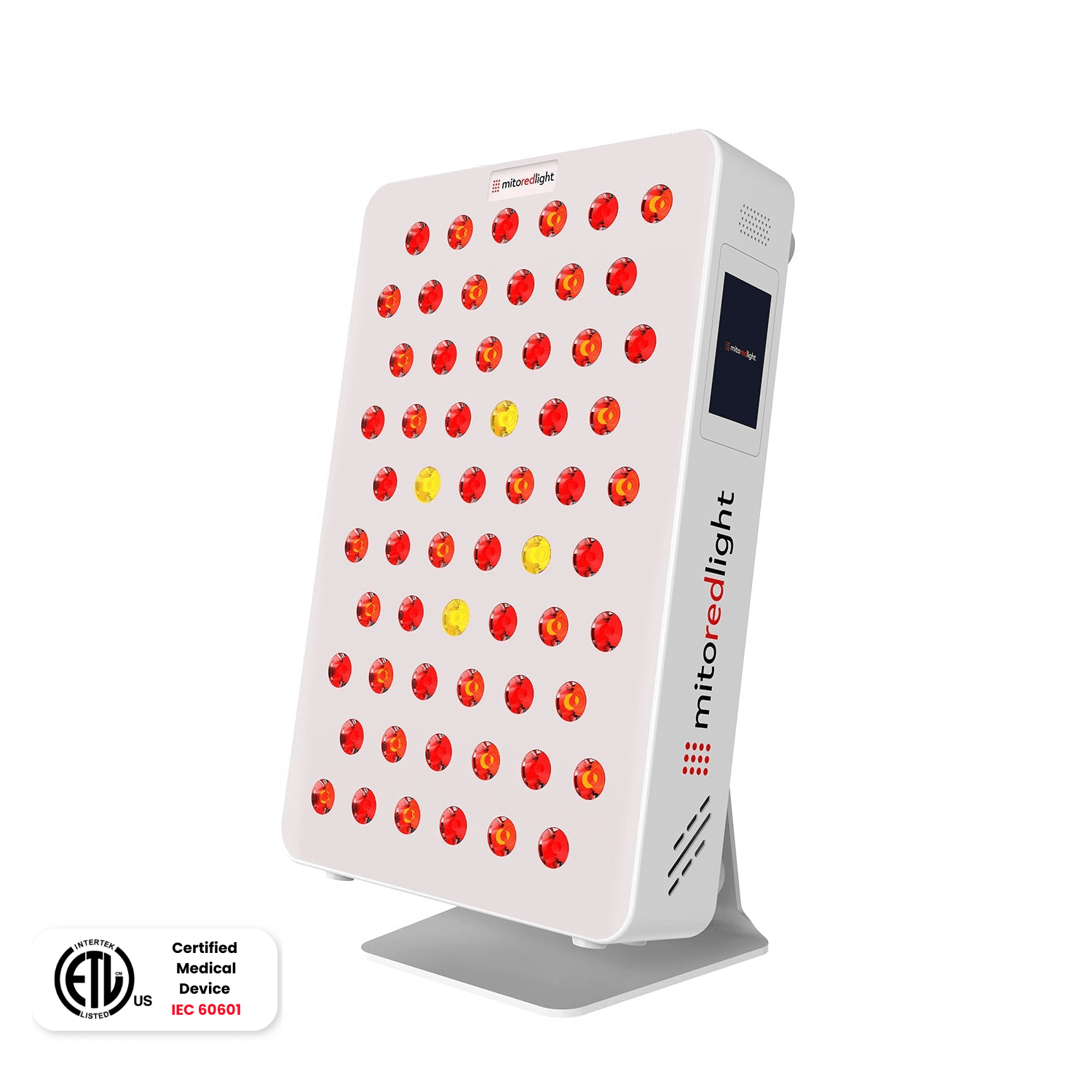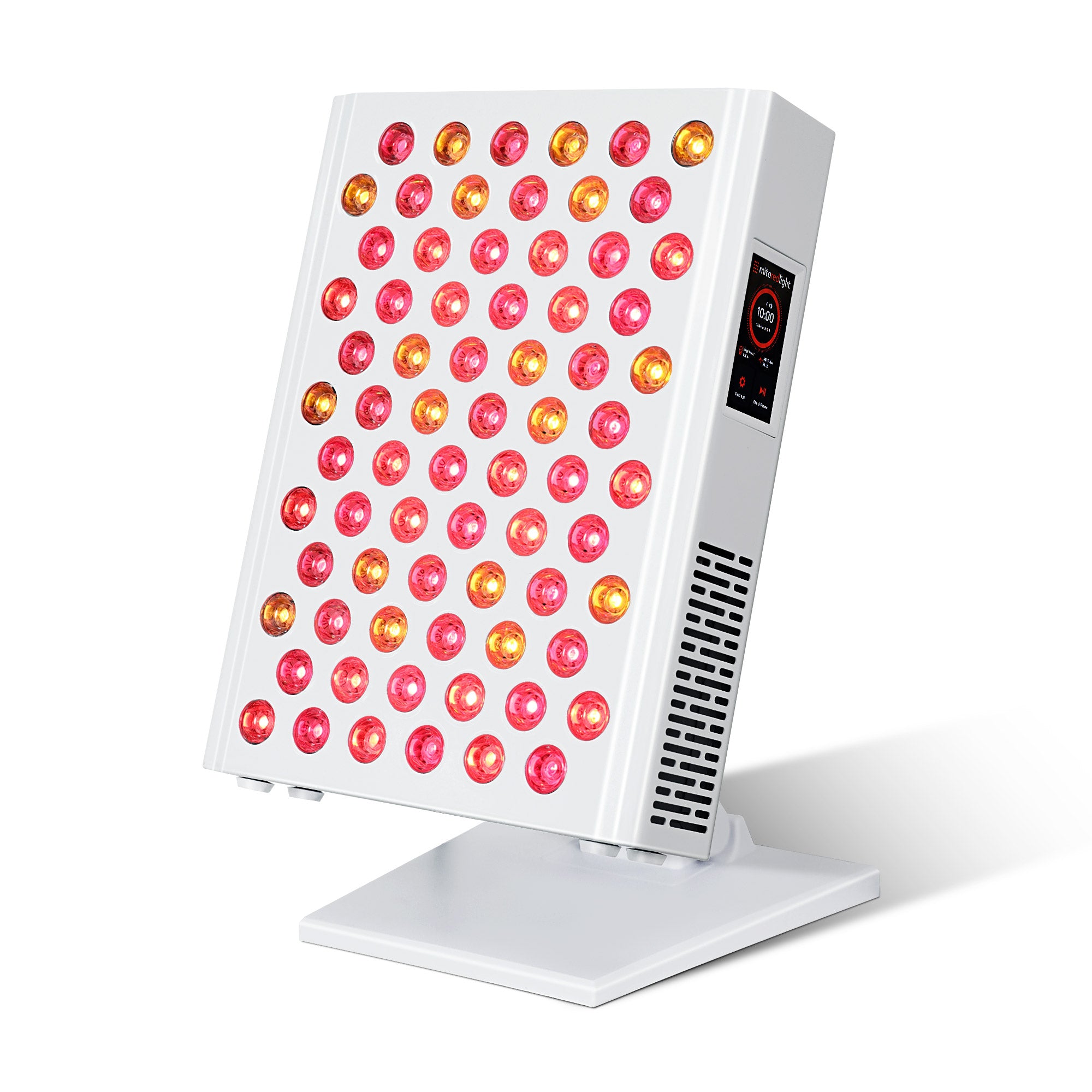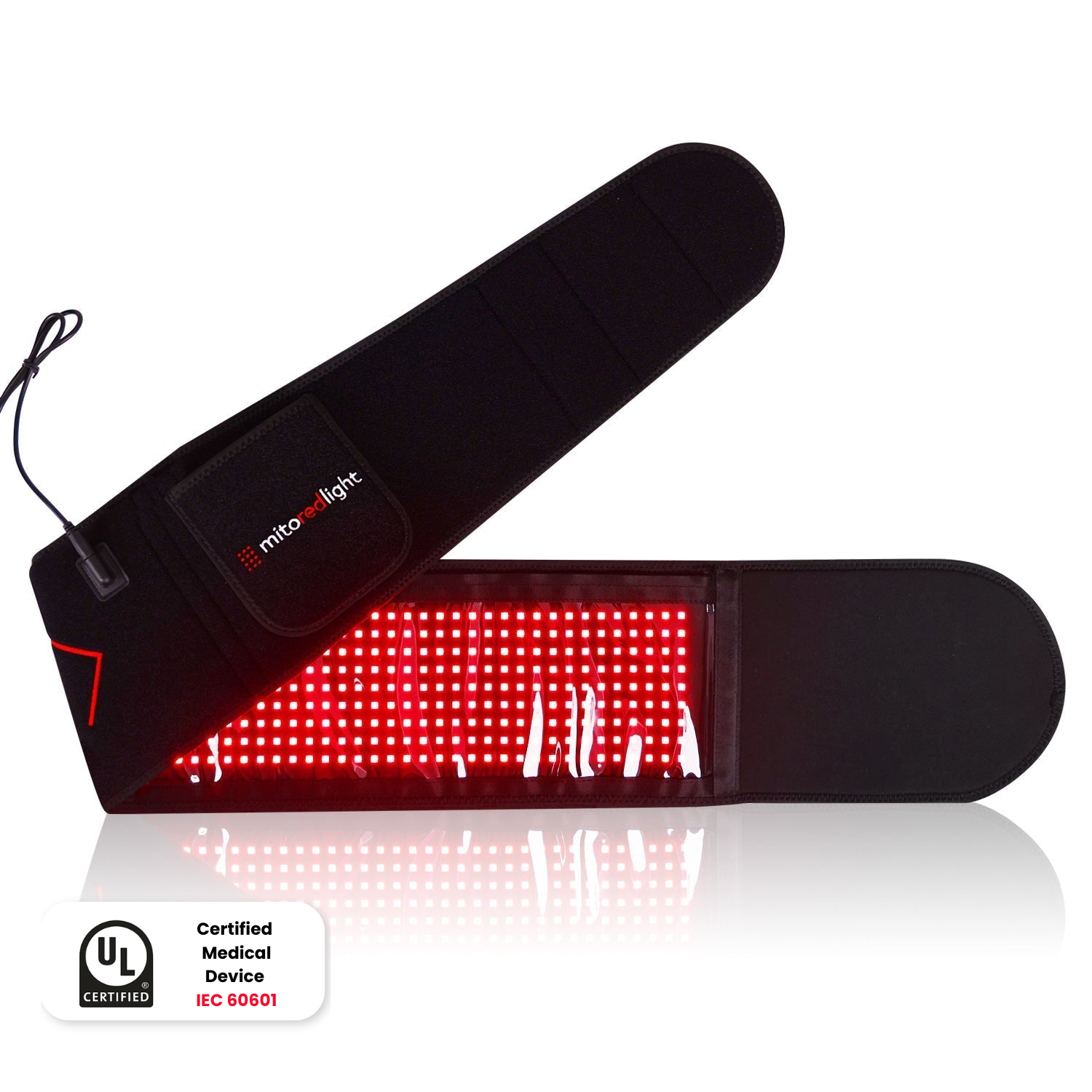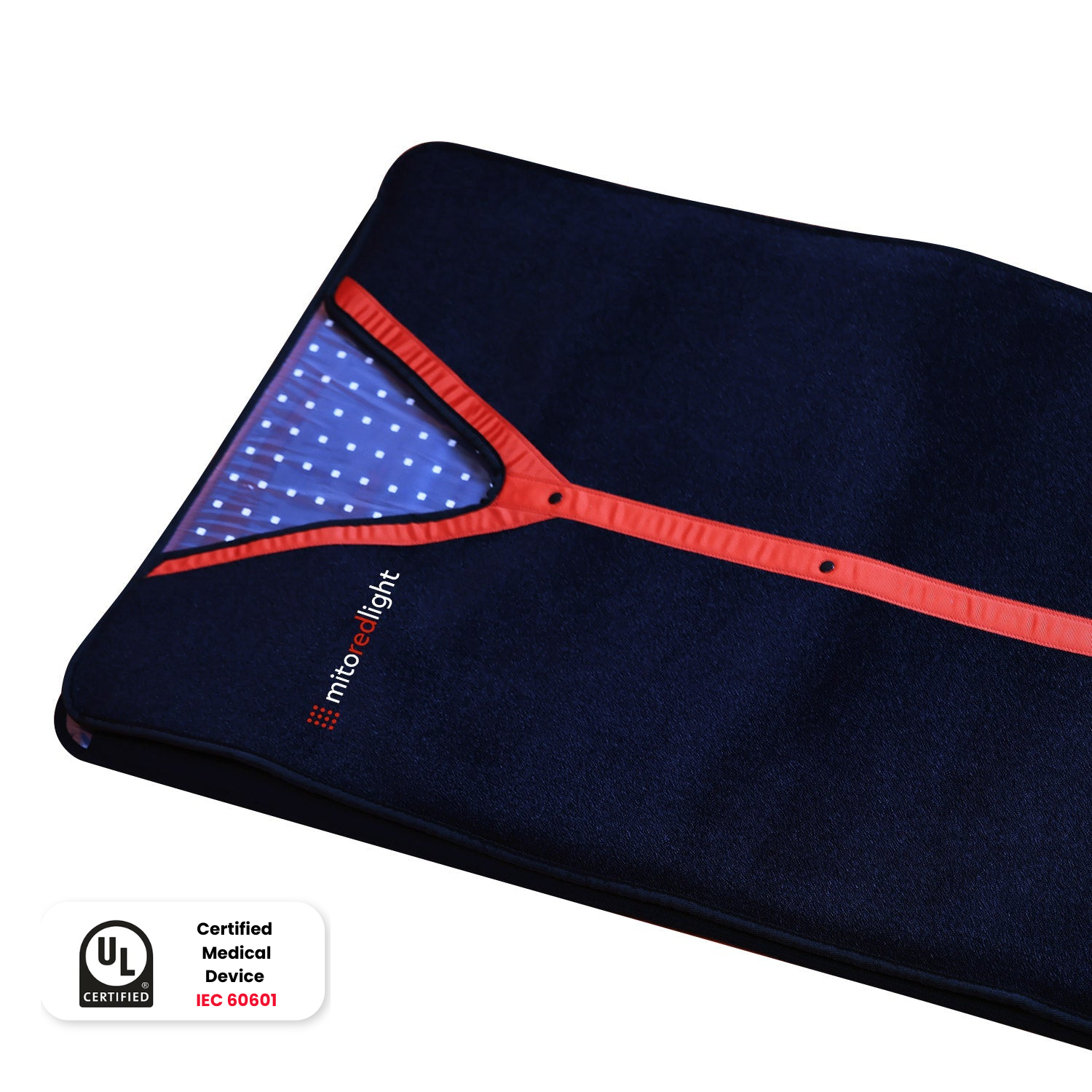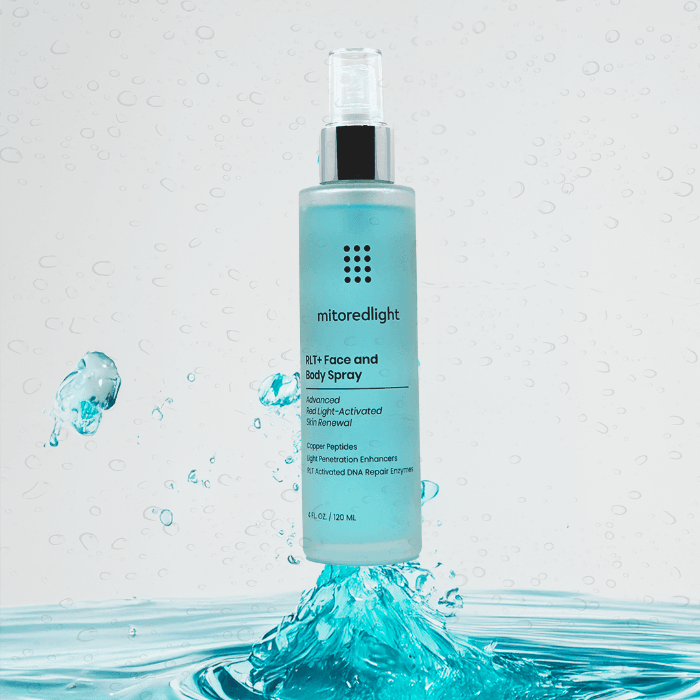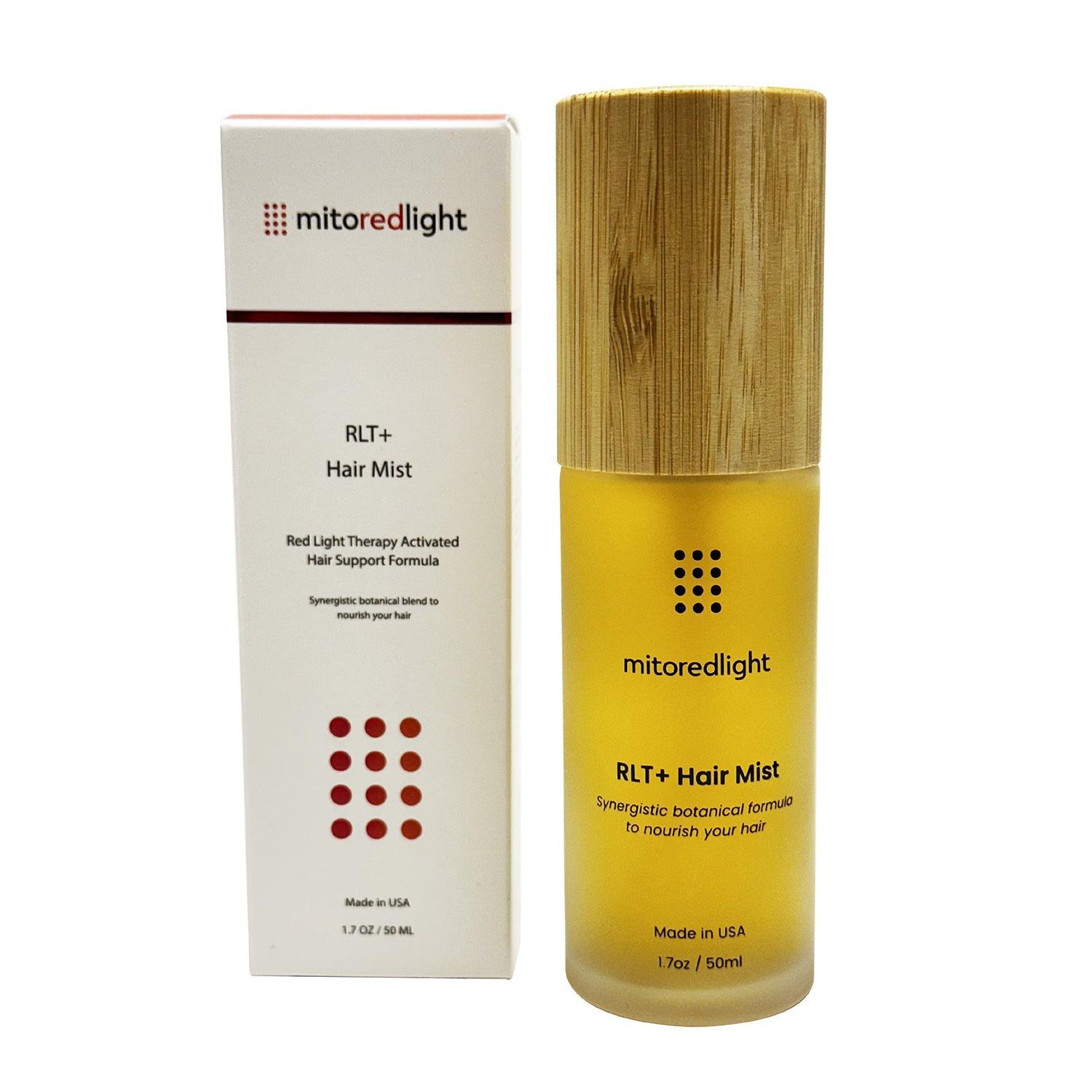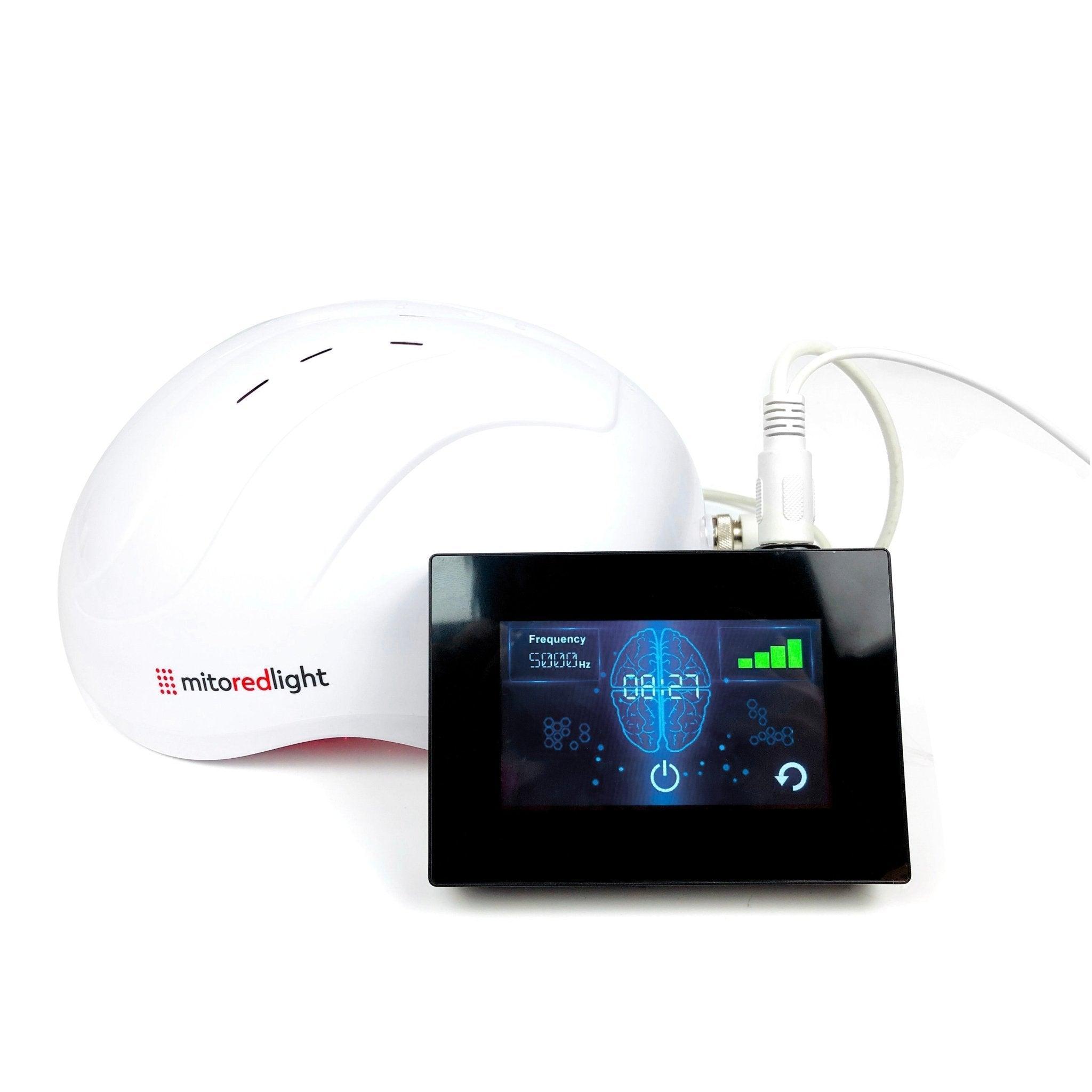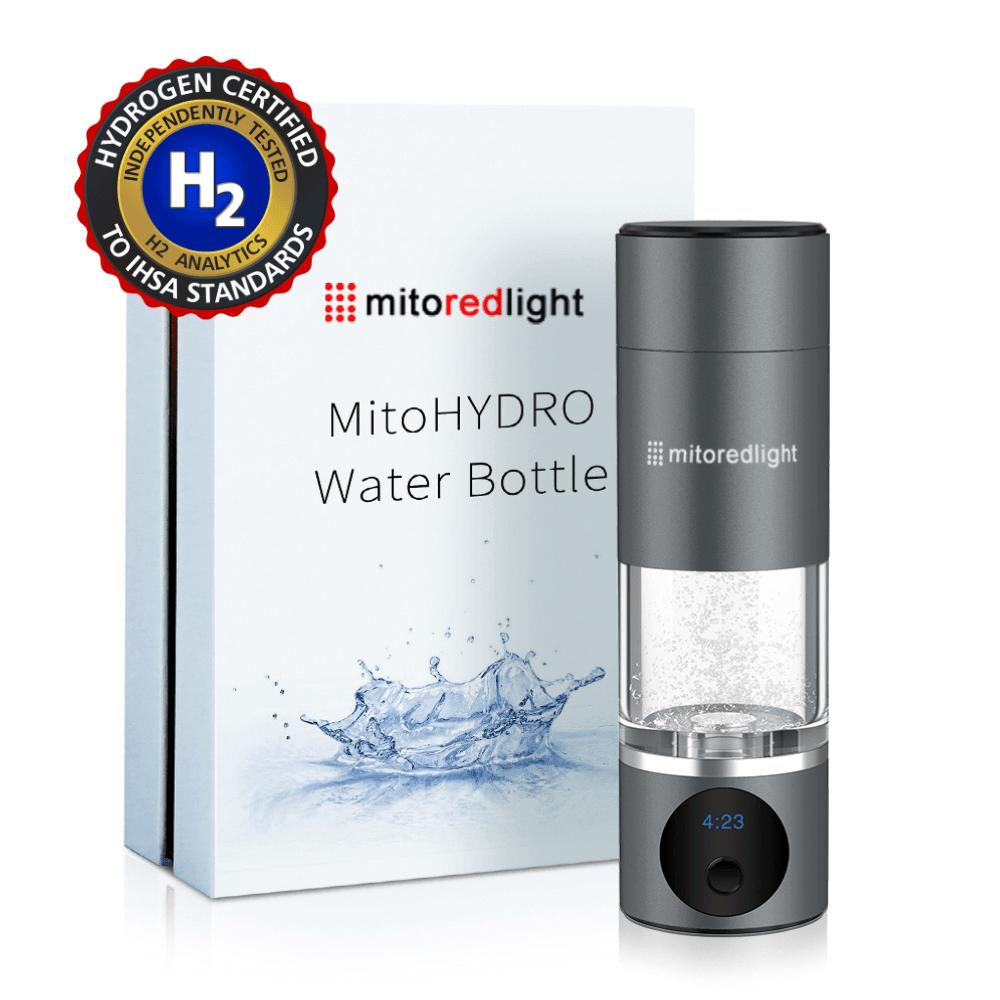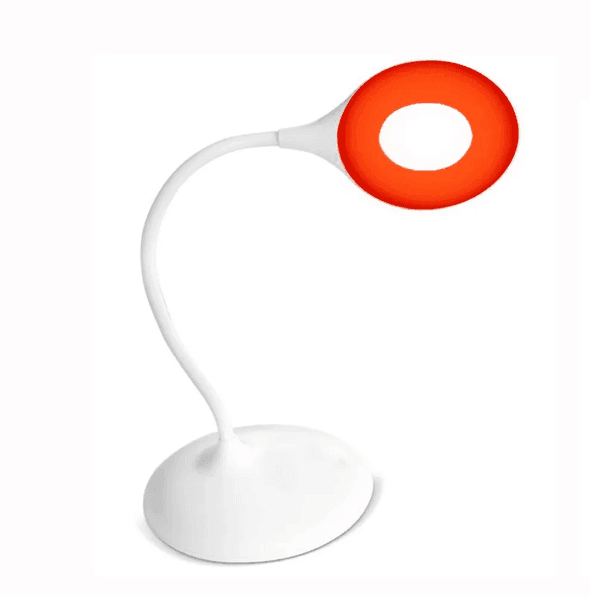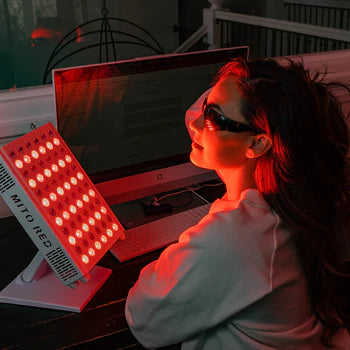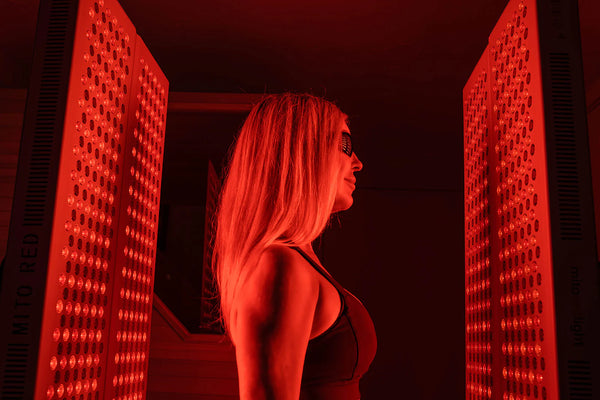Summary: Learn the difference between red and near-infrared light and how their depth of penetration affects skin and deep tissue repair.
Understanding Red and Near-Infrared Light
Red light therapy and near-infrared (NIR) therapy have become increasingly popular for promoting skin health, muscle recovery, and overall wellness. Both forms of light therapy work by stimulating mitochondrial function, the process that produces adenosine triphosphate (ATP), the energy currency of the cell [1]. By enhancing ATP production, these wavelengths help improve cellular energy, accelerate tissue repair, and reduce inflammation at both surface and deeper levels.
The key difference between the two lies in penetration depth. While both belong to the optical window of therapeutic wavelengths (roughly 600–1100 nm), their biological targets vary depending on how far the light travels through skin and tissue layers.
-
Red Light (620–700 nm): Penetrates the outer layers of the skin, reaching the epidermis and dermis. It’s ideal for surface-level skin concerns such as wrinkles, pigmentation, acne, and inflammation, making it especially beneficial for anti-aging and skin rejuvenation applications.
-
Near-Infrared Light (NIR) (700–1100 nm): Travels much deeper into the body, reaching muscles, joints, and connective tissues. This makes NIR particularly effective for pain relief, muscle recovery, joint health, and deep tissue repair. Because it’s absorbed less by melanin, NIR can penetrate deeper across all skin tones without excessive heat buildup.
Together, these wavelengths complement each other, offering a comprehensive photobiomodulation effect with red light supporting skin vitality and surface healing, and NIR light promoting deep recovery and systemic wellness.
Red Light and Its Impact on Skin
Red light, with a wavelength range of 620–700 nm, is designed to target the outer layers of the skin. Its primary action occurs at the surface level, making it ideal for addressing common skin concerns such as fine lines, acne, hyperpigmentation, and other visible signs of aging.
Red light therapy stimulates fibroblasts in the dermis, which are crucial for collagen production. By enhancing fibroblast activity, red light helps promote collagen synthesis, improving skin elasticity and firmness. This process not only reduces fine lines and wrinkles but also accelerates the healing of skin damage. Additionally, red light helps reduce inflammation, further contributing to skin rejuvenation and an overall healthier complexion [2] .
The MitoPRO X and MitoADAPT panel series feature dual chip LEDs, allowing the entire panel surface area to emit red light wavelengths, providing more comprehensive skin benefits by addressing both surface-level concerns and deeper tissue rejuvenation. The key advantages of red light for skin include::
-
Targets the Skin's Surface: Red light primarily affects the epidermis and dermis, making it effective for treating surface-level concerns like wrinkles, pigmentation, and minor scars.
-
Boosts Collagen Production: The shallow penetration helps stimulate fibroblasts, responsible for collagen production, resulting in smoother, firmer skin.
-
Reduces Inflammation: Red light is highly effective at calming redness and inflammation, helping with conditions like acne, rosacea, and skin irritation.
-
Improves Skin Tone and Texture: Regular use of red light can enhance skin texture, resulting in a healthier and more youthful appearance.
-
Reduces Hyperpigmentation: By targeting the superficial layers, red light helps fade sun spots, age spots, and other forms of hyperpigmentation, promoting an even skin tone.
-
Speeds up Wound Healing: Since it works on the surface, red light therapy accelerates the healing of cuts, abrasions, and minor wounds by improving circulation and tissue repair.
Why Red Light Is Effective for Skin Rejuvenation
The differences between red light and near-infrared light become even more significant when considering specific use cases. Red light’s ability to penetrate the outer layers of skin makes it ideal for treating superficial skin concerns. Here are some reasons why red light may be preferred in certain situations [3]:
-
Hyperpigmentation: Red light helps reduce excess melanin and promotes an even skin tone, making it particularly beneficial for sun spots, age spots, and melasma. Since red light is absorbed more by melanin, it’s highly effective for treating surface-level pigmentation concerns.
-
Anti-Aging: Red light stimulates collagen and elastin production, improving skin elasticity and reducing fine lines. It may be particularly effective for thinning skin, helping to restore thickness and firmness for a more youthful appearance.
-
Sensitive Skin: Red light is often used to treat sensitive skin conditions like rosacea or acne, as it works on the skin’s surface without stimulating deeper tissues.
-
Clinician Preferences: Many aestheticians prefer red light for skin rejuvenation, anti-aging, and superficial treatments, as it can effectively address issues without the deeper penetration required for muscle or tissue recovery.

Near-Infrared Light and Its Deep Tissue Benefits
Near-infrared light, with wavelengths ranging from 700–1100 nm, penetrates much deeper into the body than red light. It reaches beyond the skin to target muscles, joints, and deeper tissues, offering significant benefits for those dealing with issues that go beyond surface-level concerns.
A key mechanism behind its effectiveness is the stimulation of nitric oxide (NO) release in endothelial cells. NO acts as a potent vasodilator, promoting the dilation of blood vessels and enhancing blood flow. This increased circulation improves the delivery of oxygen and nutrients to tissues, which accelerates recovery and repair processes. Furthermore, nitric oxide helps mitigate oxidative stress by modulating cellular activity, reducing inflammation, and promoting healing in deeper tissues. The deeper penetration of near-infrared light makes it especially effective for treating soft tissue injuries, muscle strains, and chronic joint pain [4].
For example, devices like the MitoQUAD Belt and MitoMAT, which feature 2/3rds of their LEDs in the near-infrared spectrum, provide targeted therapy for deeper tissue repair and muscle recovery. Here’s why near-infrared light is so effective::
-
Deep tissue penetration: NIR light can penetrate deeper than red light, reaching muscles, joints, and even deeper tissues that cannot be effectively treated with surface-level red light.
-
Reduced inflammation in deep tissues: It reduces inflammation not only in the skin but also in deeper tissues, making it effective for muscle recovery and joint pain.
-
Improved circulation: NIR light increases blood flow and stimulates the production of nitric oxide, helping to dilate blood vessels and improve circulation to promote tissue healing at deeper levels.
Why Near-Infrared Light Matters for Deep Tissue Repair
Near-infrared light is ideal for treating muscle recovery, joint pain, and other deeper tissue concerns. Here’s why it’s especially beneficial [5]:
-
Muscle recovery: NIR light enhances blood circulation and oxygen delivery to muscles, reducing soreness and promoting faster recovery after physical activity or injury.
-
Joint pain and inflammation: It’s especially effective for relieving joint pain, arthritis, and muscle inflammation, as it penetrates deeply to reach these areas.
-
Enhanced tissue repair: The deeper penetration promotes tissue regeneration and speeds up the healing of soft tissue injuries, including muscle strains and ligament damage.
-
Benefits for darker skin tones: Since near-infrared light is absorbed less by melanin compared to red light, it may provide additional benefits for darker skin tones [6]. This allows for deeper penetration without excessive heat buildup in the outer layers.
Advancements in Light Therapy Devices
Recent innovations in red light therapy devices have made it easier to target specific wavelengths and deliver more even light coverage across the treatment area. Modern systems use advanced optics and LED configurations to optimize both energy distribution and wavelength precision. This ensures that each treatment delivers consistent irradiance levels, a critical factor in achieving effective photobiomodulation without generating unnecessary heat.
The MitoAdapt 4.0 Series exemplifies this new generation of smart light therapy design. It features multi-circuit wiring that allows it to function as seven different panels in one, offering unmatched flexibility for users. Each lens integrates both red and near-infrared chips that can be driven independently in the same optical housing.

Innovation in Wavelength Control and Distribution
One of the most important developments in light therapy design is the ability to control how wavelengths are distributed across a panel. The MitoAdapt 4.0’s even diode mapping ensures uniform energy delivery whether the device is used for red light alone, near-infrared alone, or in various combinations. This balanced distribution minimizes hotspots and maximizes tissue coverage, allowing for more efficient results in both skin rejuvenation and deep tissue recovery. Whether targeting fine lines on the surface or muscle fatigue beneath the skin, this level of control enables precise, science-backed treatment for a wide range of applications.
References:
1. Wunsch, A., & Matuschka, K. (2014). A Controlled Trial to Determine the Efficacy of Red and Near-Infrared Light Treatment in Patient Satisfaction, Reduction of Fine Lines, Wrinkles, Skin Roughness, and Intradermal Collagen Density Increase. Photomedicine and Laser Surgery, 32(2), 93–100. https://doi.org/10.1089/pho.2013.3616
2. Kim, M.-S., Cho, Y.-I., Kook, M.-S., Jung, S.-C., Hwang, Y.-H., & Kim, B.-H. (2015). Effect of 660 nm Light-Emitting Diode on the Wound Healing in Fibroblast-Like Cell Lines. International Journal of Photoenergy, 2015, Article ID 916838. https://doi.org/10.1155/2015/916838
3. Chopra, S., Morrissette, K., Fan, E., & Hendren, S. (2025). Photobiomodulation and Photodynamic Therapy Using Red LED Light in Dermatology: A Narrative Review. Bratislava Medical Journal. https://www.researchgate.net/publication/394024640_Photobiomodulation_and_Photodynamic_Therapy_Using_Red_LED_Light_in_Dermatology_A_Narrative_Review
4. Dima, R., Francio, V. T., Towery, C., & Davani, S. (2018). Review of literature on low-level laser therapy benefits for nonpharmacological pain control in chronic pain and osteoarthritis. Alternative Therapies in Health and Medicine, 24(5), 8–10. https://pubmed.ncbi.nlm.nih.gov/28987080/
5. Costa do Bomfim, F. R., Gomes, B. S., Lanza, S. Z., Esquisatto, M. A. M., & Lopes-Filho, G. J. (2023). Photobiomodulation effects on synovial morphology, iNOS gene, and protein expression in a model of acute inflammation. Acta Cirurgica Brasileira. https://pubmed.ncbi.nlm.nih.gov/38511763/
6. Liebert, A. (2015). Quantification of the absorption of low-level 904 nm super pulsed laser light as a function of skin colour. Lasers in Medical Science. https://www.researchgate.net/publication/269316866_Quantification_of_the_absorption_of_low-level_904_nm_super_pulsed_laser_light_as_a_function_of_skin_colour
DISCLAIMER: Mito Red Light devices are Class II wellness devices aimed at affecting the body through supporting cellular function. The information provided in this article and on this site is for educational purposes only and is not intended to imply effectiveness of Mito Red Light devices for any specific application. The information provided in this article and on this site is not intended to diagnose, treat, cure, or prevent any disease, is not a substitute for consultation with a licensed medical provider and should not be construed as medical advice. Click here to read our article on potential contraindications of red light therapy..
